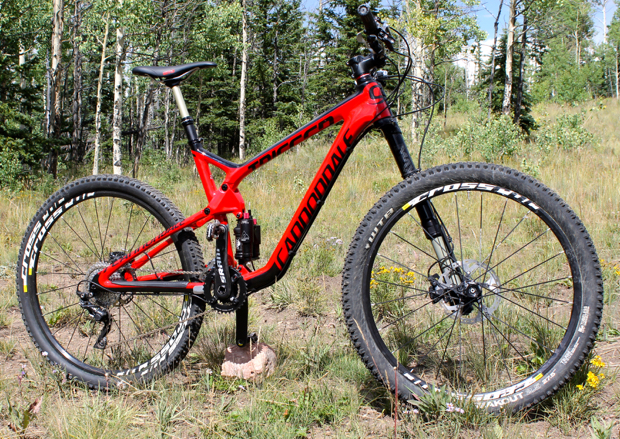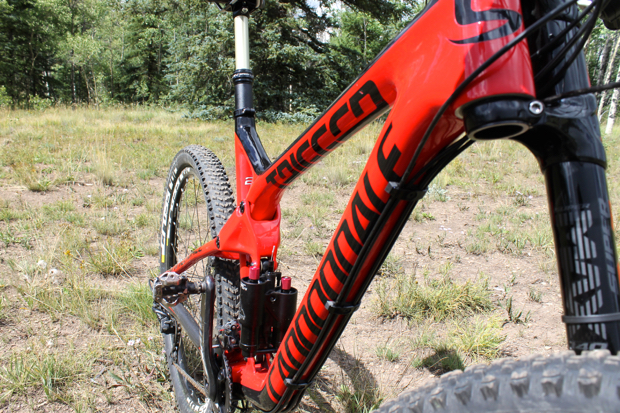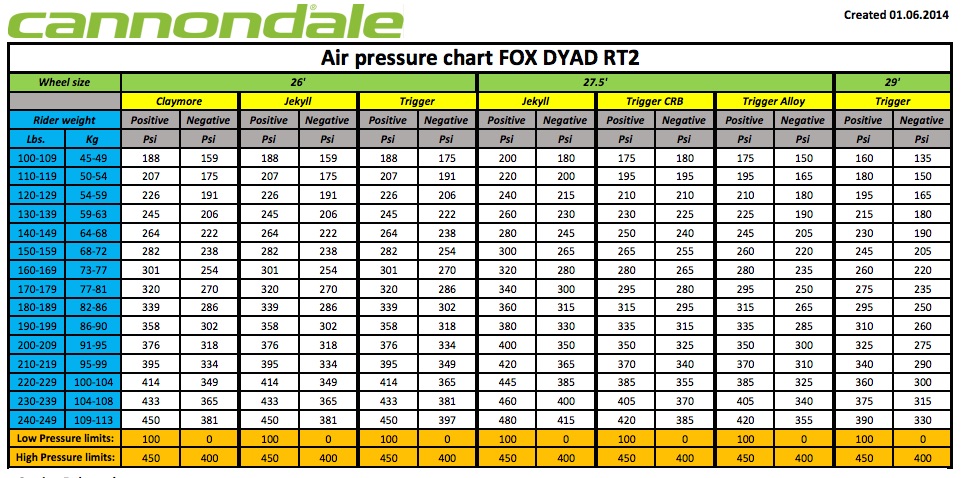The 2015 Cannondale Trigger Carbon 2 27.5 is a part of Cannondale’s new Overmountain lineup. All of the Overmountain bikes were designed to provide a 2-in-1 ride quality, thanks to their unique suspension design. When I heard that the Trigger was on its way over, I decided that the Crested Butte Ultra Enduro would be the perfect testing grounds to pummel this new bike and unique concept… and to see if it could stand up to the challenge.

Build Kit
Before we get to the core of the Trigger–the suspension–here’s what you need to know about the parts spec: the Trigger Carbon 2 features a full Shimano XT 2×10 drivetrain with Shadow Plus rear derailleur, as well as bombproof XT brakes. Simply put, these parts are tried and true, and over the course of my review they performed admirably, and I experienced no issues. A dependable KS Lev dropper post, WTB Silverado saddle, and Cannondale C1 carbon riser bar with Cannondale lock on grips round out the cockpit.
The wheel and tire combination were both Mavic Crossrocs, and to be honest I was extremely underwhelmed with the Crossroc tires. They were too narrow, didn’t have very good tread, and didn’t want to ride well on the rim when mounted tubeless. I even burped a tire on a rocky wall ride on my first shakedown, which might actually be the first time I’ve burped a tire–oh joy! In my opinion, the Crossmax tires would be a much better fit, and the Crossmax wheels wouldn’t go amiss, either. However, with a different pair of tires mounted up, the Crossroc wheels performed well, even if they felt a bit under-gunned. If you’re going to push the Trigger more toward the all-mountain end of the spectrum, a beefier pair of wheels wouldn’t be a bad choice. But if you’re comfortable with long pedally and climbs and not blasting off big drops on the descents, the Crossroc hoops will be more than adequate.
The Carbon 2 build kit I reviewed retails for $6,170, with two models priced above it and the top-tier Carbon Black model hitting the registers at $10,830. There are also two models priced below this one, with the most affordable Trigger 4 alloy model retailing for $3,140.
With its stock setup, my size-medium Trigger weighed in at a very respectable 27.8lbs without pedals.
Geometry and Frame
The Trigger features 140mm of suspension, placing it squarely in the “trail bike” category. Riding a 27.5 trail bike was a new experience for me, but the shorter amount of travel, lighter build, and slightly-steeper geometry make it much more pedal-friendly, which is one of the reasons why I chose to race it during the Crested Butte Ultra Enduro. The Trigger sports a headtube angle of 68 degrees, an effective seat tube angle of 73.5 degrees, an effective top tube length of 59.8cm, 43.8cm chain stays, and a wheelbase of 115.1cm. All of these stats combine to create a bike that’s a fast, capable climber, yet one that can descend at high speed.
The Trigger Carbon 2 is fully-carbon (no aluminum rear triangle or chainstays here), and utilizes Cannondale’s BallisTec Hi-MOD Carbon. The carbon is covered with a beautiful glossy red paint that shines brilliantly in the sun.
Suspension: SuperMax Lefty Strut
While the frame is beautiful, the parts are dependable, and the weight is light, what really sets the Trigger apart from other bikes is its unique suspension set-up. Most visibly, up front the Trigger is rocking the new SuperMax Lefty. In short, the new SuperMax is designed to be lighter, stiffer, and better than ever before. My test bike came equipped with the 140mm model, which features the same chassis as the 160mm, but is internally limited to just 140mm of travel. The massive tubing makes the SuperMax extremely stiff, with a 36mm lower tube and a huge 46mm upper tube. However, even with these large tubes and dual crown, the single strut keeps its total weight down to 1,850g.
Since the Supermax has the same chassis throughout, if at some point in the future you wanted to convert the 140mm to a full 160mm, it’s relatively easy to do. According to Cannondale, “you would have to purchase a new 160 damper cartridge which fits right into the upper leg. Then you remove the lower air assembly, remove a 20mm spacer that sits in the bottom of the leg, and you’re all set.” Pretty simple. If this was my personal bike, this is an upgrade I’d seriously consider. And even if you think 140mm will be plenty, it’s great to know that the option is there if you need it.
This was my first time riding a Lefty fork, and I was unbelieveably excited! Spending some serious time on a Lefty has been on my bucket list for years, and now I was finally able to give it a go. At first, my brain had a hard time getting over the fact that my fork wasn’t a fork, but was instead a strut. But when I pointed the bike down the trail and just focused on mountain biking, it became clear that the SuperMax isn’t here just to make a visual statement, but it has a real job to do–and it does it superbly well.
The SuperMax rides just like you’d expect any other suspension fork to ride. It’s plush, yet firm when it needs to be, soaking up trail chatter and big hits alike. The unique Poptop lockout system is extremely easy to use on the fly: just slap the big red thing to stiffen it up, and push the blue bit to open it back up. Interestingly, while the Poptop does make for a much stiffer ride and a really great climbing feel, it does feature a blow off valve in case you forget to open it back up when you descend. While not ideal, the blowoff can save your ass in a bad situation, and will keep you from destroying anything on the Lefty internally.
Suspension: DYAD Shock
While the Lefty is the most visually-interesting suspension component, the DYAD rear shock is arguably the most revolutionary technologically. For starters, the DYAD is an incredibly-rare pull shock. Yes, that’s right: instead of pushing into the shock, the suspension pulls it out. Don’t ask me exactly how it works–it just does.
While that might be the DYAD’s weirdest feature, it’s not the most outstanding. The DYAD isn’t just one shock: it’s essentially two shocks in one. While complex shocks like the Cane Creek Double Barrel have adjustable valving that allows you to switch between long travel and short travel mode, the DYAD has two separate sets of air chambers, for a total of four different air pressures to adjust and two different sets of rebound speed to adjust. If you think that sounds complicated, you’re be right–but thankfully Cannondale has provided a handy cheatsheet to give you starting pressures to use as your base values, which you can then tweak according to your individual riding style.
The Trigger ships with its own shock pump. At first I was like, “what do I need another shock pump for? I already have too many of these!” But when I looked at this table of pressures, I understood: most standard shock pumps can’t physically provide pressures this high! The supplied pump, on the other hand, is specially-designed to handle high air pressures of over 500psi.
The benefit of having two completely-separate sets of air chambers is that the rear shock can consequently provide two totally different amounts of rear suspension: 140mm and 85mm in the case of the Trigger. Now, unlike a FOX CTD shock, switching to the short-travel “Elevate” mode doesn’t stiffen or lockout the shock. Rather, the short-travel mode is a fully-active 85mm that is individually tuneable from the longer-travel 140mm option. Especially for real mountain biking on singletrack trails, you really should never completely lock out your suspension. An active suspension, but with shorter travel, functions to provide better traction in steep terrain and soaks up small trail chatter, while providing a firmer pedaling platform than a full-length shock.
I personally found the short-travel mode invaluable on long climbs. Also, I really appreciated the individual tuneability. I set up the short travel mode with a stiffer and slightly-faster rebound rate, while I aimed for as plush of a ride as possible with the long-travel mode. Thanks to a handlebar-mounted remote, I switched between the two settings often.
While I loved the DYAD in Elevate mode, in the full-travel “Flow” mode I found that it left some performance to be desired. When I was riding the bike within the limits of its capabilities, the shock performed admirably and the rear wheel tracked superbly. However, when I pushed the Trigger too far, it fought back. The DYAD bottoms out extremely harshly, with a clunk and a jolt that would whip me forward. Also, I found the rear end to clunk severely on square-edged hits, with the bike almost getting caught on square rocks and stopped in its tracks.
I had a hard time determining the cause of this harsh bottom out. I tried tweaking air pressures and rebound/compression rates, and I wasn’t able to eliminate it. That said, during the course of my test I did ride this bike far beyond the intended application of a 140mm trail bike (keep reading for my general ride impressions), but I’ve done this with trail bikes before that just kept on plugging away, even when abused.
General Ride Impressions
I chose the Cannondale Trigger Carbon 2 27.5 as my race bike for the Crested Butte Ultra Enduro because of its unique combination of characteristics. With long miles and many thousands of feet of climbing, I wanted a bike that wouldn’t burden me unduly on the climbs, and yet would be able to descend the singletrack mountain passes at race pace.

Climbing
Thanks to the light weight, superb adjustability afforded by the DYAD, and the excellent geometry, the Trigger climbed like a champ! I tackled miles and miles of climbing aboard this beast, and I loved it as much as one can enjoy pedaling a bike up a hill.
Rolling Trail
In my opinion, rolling trail is where the Trigger truly excels. 140mm of travel is a good bit but it’s not a ton in the grand scheme of things. However, 140mm is perfect for maching along rolling, rocky trails, with pedally sections, descents, and a general good mix of everything. Hence the “trail” categorization: it’s for riding average trails.

Descending
I did indeed race the Trigger through 10 stages of the Crested Butte Ultra Enduro, and I posted some good times along the way! Thanks to an incredibly solid frame, bomber parts spec, and astoundingly stiff and responsive suspension strut (aka the Lefty Supermax), I was able to rip down the mountainsides through ridiculously technical, steep, washed-out trails, at what most people would consider unwise speeds. And the capability of the Trigger is confirmed when I say that this bike doesn’t really do well in this application.
“Wait, doesn’t do well at this? What do you mean?”
When ridden within its boundaries, the Trigger is a stupendous mountain bike. These boundaries can stretch a really long way, and include stupid-fast descents, drops, endless rock gardens, jumps–you name it. But when you push past the boundaries, you’ll know it. The rear shock will bottom out and squwak like there’s no tomorrow. The wheels will start pinging and groaning at you. And while the SuperMax won’t bottom out harshly, you’ll keep reaching for more travel up front and wishing you had it. I quickly pushed this bike past its boundaries while shredding double black diamonds in the Evolution Bike Park.


But let’s be honest here: this bike just isn’t meant to be ridden like that. While some other bikes will acquiesce to the rider’s demands when pushed past their intended use, the Trigger, on the other hand, will protest, complain, and refuse to go further.

Bottom Line
For standard trail riding with big climbs, long rolling sections of trail, and moderately-technical descents, the Trigger is a beaut’ of a bike! The outside-the-box suspension components set this bike apart both visually and tactilely. However, if you really want to push the envelope on stupid-gnarly terrain, I’d really recommend stepping up to the Trigger’s bigger brother, the Jekyll. But if you avoid trails that might force your spouse to collect on your life insurance policy or you live in an area where the descents aren’t measured in miles, the Trigger could be the perfect bike for you.
MSRP: $6,170
[see_also id=”50939″][/see_also]






























